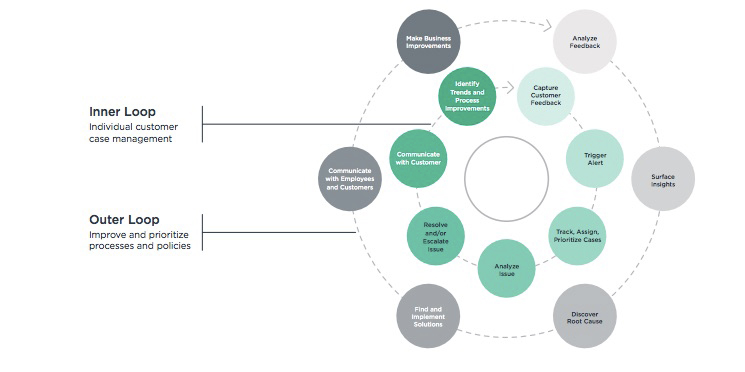Ninety-one percent of unhappy customers refuse to give your brand another chance. However, resolve that customer’s complaint, and they’re 70% more likely to become a repeat customer. Each customer complaint represents a fork in the road that contains the opportunity to make your business stronger or tear it down little by little. Multiply it by the number of complaints you get in a year and that’s either a big liability or a whole lot of potential for your customer loyalty, depending on how you close the customer feedback loop.
Successful case management, or “closing the loop” on customer issues is a foundational element of any successful CX initiative. Now that customer experience has become the rage, it’s tempting for brands to jump ahead to the more trendy and scintillating areas like AI, personalization and “delight.”
However, without mastering this essential first step, all other efforts will fall flat. And while the process has hurdles, the benefits are well worth the effort, and there’s a fairly straight forward ROI naturally built in. Studies show that an increase of just 5% in customer retention can boost profits by up to 125%. And whether that accurately reflects your business, one thing is clear: For every customer you save, many dollars are earned.
Here’s how to get started on creating, or evolving your closed-loop program:
Understand the loop
Forty-two percent of consumers said that when they contact a brand for support, they expect a response within 60 minutes. Given this expectation, understanding what’s behind the customer feedback loop is essential in understanding how to close it.
In the world of customer experience, the term “closing the loop” was popularized by Fred Reichheld and Bain & Co. in their Net Promoter System, a comprehensive way of structuring immediate resolution of customer concerns, and applying the intelligence inside that feedback to improve all areas of a business. And while NPS is a popular and useful model, closing the loop as a concept that can be successfully applied to any customer experience framework.
We’ve developed our own take on a closed loop visualization. The inner circle represents the process of identifying and resolving individual customer issues, and also communicating those actions back the customer, and the employees who serve them. This “inner loop” is also often referred to as case management. The outer loop represents the bigger picture — the process of identifying and resolving larger organizational patterns and trends based on the aggregation of customer feedback, or identifying and taking action on root cause.

When it comes to implementing a customer experience program within an organization, this closed-loop model is a great process. However, there’s an additional element missing that’s essential to both that immediate and broader success: the frontline employees’ viewpoint, or Voice of Employee feedback.
Empower your employees
Understanding how the customer feels is obviously valuable, but it’s only part of the story. Frontline employees have a unique view to the customer’s journey. They can offer pointed insights into which processes are and aren’t working, and ideas on solutions to optimize the customer experience. This type of feedback is called Voice of Employee, or VoE, and differs from the traditional employee survey feedback where companies ask their workforce to weigh in on their experience as employees. VoE is employee feedback about the customer experience. This type of intelligence is powerful. In fact, a study by InMoment and CustomerThink found that 66% of CX professionals consider employees the top source of actionable insights about their customers’ experiences.
And when you’re closing the loop, don’t forget to let employees know that you’ve heard them, and how their participation in the process is helping improve the customer experience. Creating authentic areas of contribution and ownership makes for a more effective CX strategy, and more engaged, effective, and loyal employees.
Get executive buy-in
It may be a cliche notion, but it doesn’t make it any less true: success starts at the top. Customer experience is more than a survey. It’s more than personalizing emails or offers. It’s more than resolving every single customer concern. Simply stated, CX is a comprehensive way of doing business. And thanks to this high-order nature, even the most basic elements, like case management, must be prioritized by leadership in order to be successful.
Gaining that executive buy-in is best done by CX pros who are part diplomat, part sales person. If you don’t already have this buy-in, understanding what really matters to both the personalities who make the decisions, and the business is critical. Take time to understand what moves those needles, and focus early initiatives on those areas. Has your business prioritized efficiency? Make sure to track action and report what you learn during customer interactions that streamlines interactions, decrease call-ins or returns, or gets rid of processes or policies that create pain for customers. Maybe your company is focusing on employee retention. The VoE element of closing the loop is an ideal way to boost that metric, given you measure and report on the impact.
If you’re starting with a resistant CEO, case studies, news articles and other stories about CX leaders they admire can be helpful in getting something started. In this case, however, it’s especially important to focus your efforts where you can get relatively fast, and easy to quantify results. An effective case management process is ideal for this scenario, and when done well, can open the door to even more opportunities to elevate your customer experience — and the value it can bring.
To engage more leaders across the business, CX leaders should repeat the same pattern: look for what matters to various stakeholders and how they’re rewarded (or punished). Look for insights from your closed-loop system that can help them make data-driven decisions.
In short, look at your organization’s leaders as an important customer segment. Listen intently. Understand what they want and need. And then deliver value that supports their success.
Break down the silos to act quickly
Businesses, especially large enterprises, are nearly always siloed: From policies and processes, to data and technology. And while separate areas of the business may not cross paths regularly, the customer data they’re collecting at the touchpoints they own (be it billing, legal, marketing, ecomm or retail) are all parts of the larger customer picture. You can close the loop all day long on customer complaints, but if you never fix what’s broken upstream, those efforts will have limited impact: like bailing water out of a boat with a large hole in the bottom.
And when silos prevent timely responses, the impact can be immediate–and harsh. Time is of the essence, since 42% of consumers said that if they contact a brand for support, they expect a response within 60 minutes. Fifty-seven percent said they expect that turnaround time regardless of time of day or day of week.
Again, here’s where your diplomat-sales skills comes to the rescue, rallying colleagues and leaders to ditch “the way things have always been” and be bold to more strongly communicate across departments. Having a leader to blaze the trail in increasing that communication is essential because it brings clarity the entirety of the customer journey, and the integral role of employees. Open communication is key to a more open and cohesive corporate decision-making process–not to mention bottom line.
The journey toward high-value customer relationships may sound daunting, and it’s easy to feel overwhelmed by the task. The key is taking one step at a time, starting with building a healthy foundation of resolving customer concerns quickly and well, and inviting employees to become true influencers in transforming your brand.
